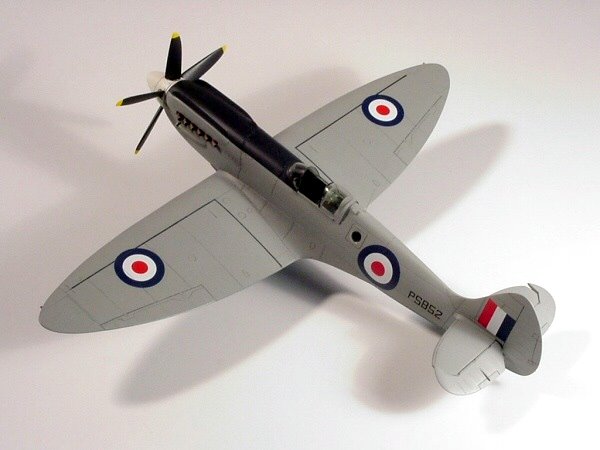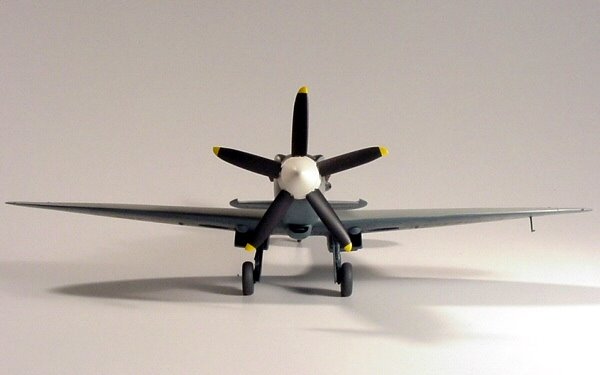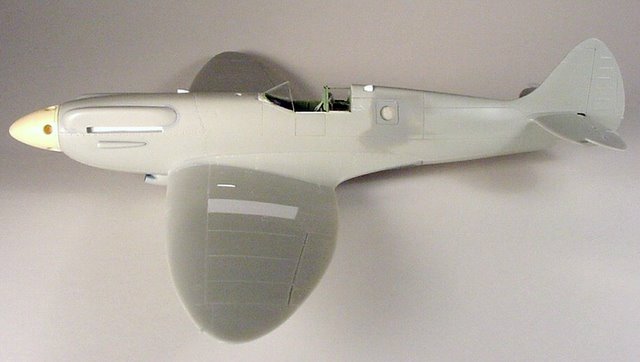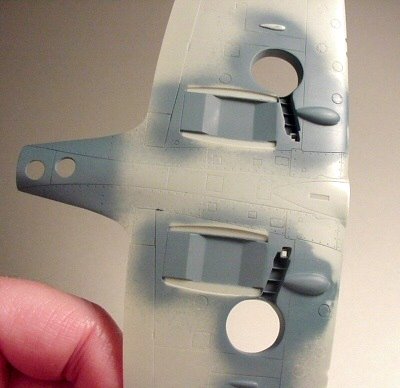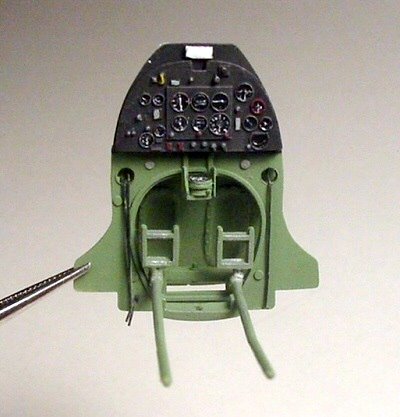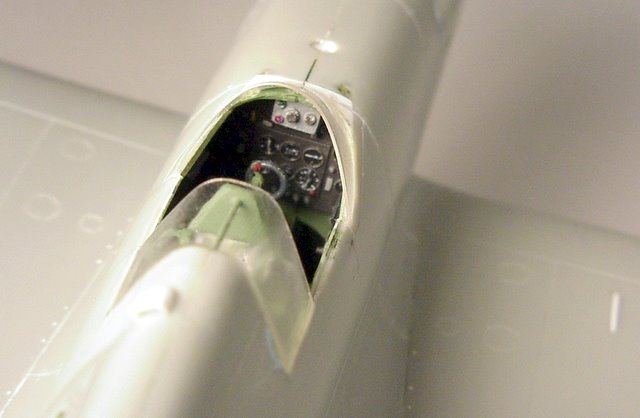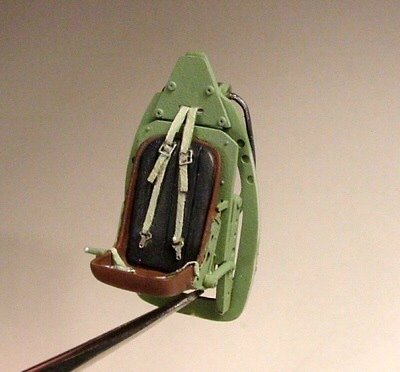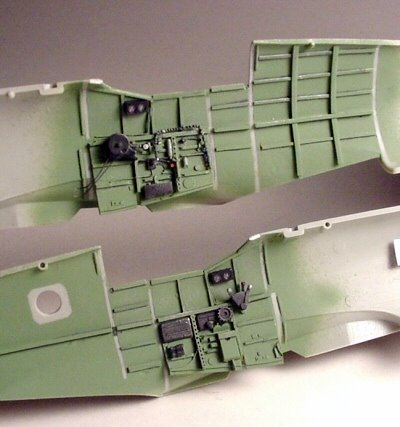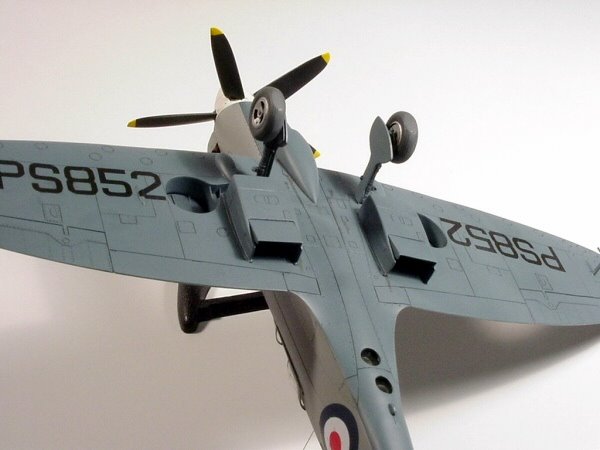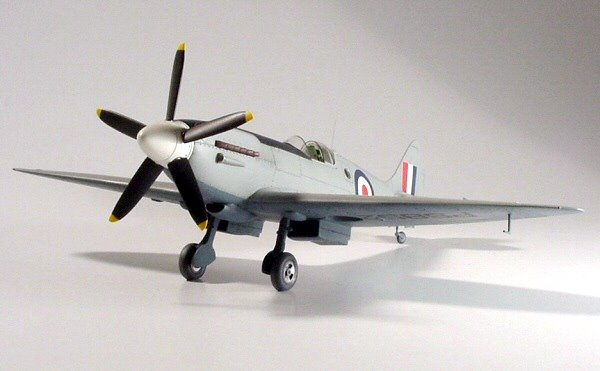The Complete Conversion Guide for 1/48 Scale
by Jim Kiker
This article is being published (almost) simultaneously at the pages of this magazine and the Spitfire Site (Ed.)
Introduction
Dedicated to Mr. Ed Powles, with respect and appreciation
Having been in the reconnaissance business myself, I have a special fondness for “recce” aircraft. Some time after Academy released their 1/48 scale Mk XIV Spitfires, I ran across an excellent walk around of the Swedish S-31 (PR XIX) in the IPMS Stockholm web site archives, and I was off!
Then, one of my local model geek buds found out I was thinking about doing the PR XIX, and he “steered” me to one of the aircraft used by (then) Flt/Lt Ed Powles. During construction, Wally also arranged for me to have a conversation with Mr. Powles; what a kick in the pants to speak with the man who flew the exact airplane you’re building! Flt/Lt Ed Powles led a two-plane detachment from 81 (PR) Squadron, based in Hong Kong in the early 1950’s. His exploits included some early cold-war aerial reconnaissance, as well as taking some of the first meteorological measurements at altitude in that region of the world. And then there was the time he took his PR XIX up to 51,000 ft. Noting a problem with the cabin pressurization, he put the nose down- and darn near went supersonic during the ensuing plunge back toward the sea. He later calculated that he got up to at least .96 Mach before regaining use of his flight controls in the denser lower air (having encountered locked controls due to compressibility near Mach 1), and levelled out approximately 1,500 ft above the sea. To top it off, Mr. Powles is over 6 feet tall and barely fit into the Spitfire with the seat fully lowered. What a great story!
The Kit
Academy produced two Mk XIV Spitfire kits, including both the ”c” winged version and the later bubble-canopied one with the “e” wing, in 1/48 scale. The Mk XIVc kit became the basis for this project.
The Academy kits build up pretty well and feature fine panel line engraving. It has some accuracy issues which will be described below. The interior detail is rather Spartan for my taste, and the propeller looks rather bad. Parts fit is fair, but this isn’t a “shake ‘n bake” kit.
KMC produced a nice resin upgrade set for this kit, and while it’s currently discontinued, it can be found. It provides a complete cockpit, new spinner and props (which is also available as a separate set, I believe), a new upper engine cowling, and new radiators, much of which I made use of to great effect.
The Conversion
Converting the Mk XIV into a PR XIX proved to be deceptively non-simple!
First, let’s address the accuracy issues.
- While the wings in the Academy kit are especially nice in shape, they are rather thick
- I have also come to the conclusion, along with some Spitfire experts, that the fuselage is a bit deep.
- The spinner and prop require some real work. Broadly speaking, the spinner is too large and the propeller blades have the wrong shape.
In my opinion, the dimensional errors with wings and fuselage would be a very difficult thing to fix. I limited myself to sanding down the forward nose area somewhat on the top and bottom during construction.
The spinner/propeller areas can be corrected by sanding.
Fuselage Tweaks List
The conversion procedure was as follows.
Using references, I marked and scribed camera access panels onto each fuselage side. The left one also got a camera port drilled out.
- The standard pilot’s entry hatch was glued into place and the seams filled in. Only the first couple of dozen (give or take) Mk. XIX aircraft were built with unpressurized cockpits and featured the standard Spitfire pilot entry hatch on the left side. Eliminating the access door only applies to pressurized aircraft, like the one I modelled.
- New cabin pressurization scoop was fabricated, to go below the left engine exhaust pipes. Again, if you build a PR XIX from during WWII, check your references to see if you need to add this scoop or not.
- The rear, fixed portion of the canopy on the Academy kit is too short from front to back and must be replaced. In addition, this piece extended down about 2” lower than normal Spitfires. I cut the rear area down even with the sliding section canopy sills, made a master, and vac-formed a new rear section. I glued this piece in place, smoothed the joins, and simply painted the horizontal frames in their correct location during painting.
- Solid pressure bulkhead at the rear of the cockpit was added. Again, this feature applies if if you’re doing a pressurized bird.
- I also decided to add some camera details since they are visible through the ports. I made a second bulkhead for the back of the camera bay, a rough approximation of the camera bodies, then added lens tubes using 1/8” plastic tubing (approximating the 6” width of these lenses). Here’s how they looked after finishing. This is not very accurate, but they look great through the camera ports! Also note the three oxygen bottles used in the XIX mounted to the front bulkhead.
- The kit’s windscreen had to be replaced with a one-piece curved unit. One of the Falcon conversion sets has one, and Aeroclub makes a set of four Spitfire canopies for different marks, including a PR. When I test-fit this piece, the leading edge sits back farther than the standard kit piece, and the round shape of the bottom of the piece doesn’t fit the kit. I added some sheet plastic to the front of the cockpit and shaped it to fit the new windscreen. 7. Using references, mark and drill out the two lower camera ports; note that they are offset slightly from the centreline of the aircraft. Mine are 3/16” diameter.
Wings Tweaks List
- The Mk XIV wings in the kit feature (correctly) the short- span ailerons used on the type; unfortunately, the PR XIX had the normal, longer-span ailerons, so I filled the outer ends of the kit’s ailerons and extended the hinge line out to where the wingtip joins.
- The PR XIX was unarmed, so of course the cannon and their upper wing bulges had to go. And so did all of the gun access panels, panel lines, shell chutes, the whole lot. I filled in all the gun panel lines with superglue, using a pin as an applicator, a short section at a time, and then hit it with accelerator. Remember to sand each line down as soon as you’re finished getting the superglue dry, before it hardens completely. Then rescribe the remaining panel lines as needed. This proved to be the most tedious part of the project!
A shot of the airframe much later during construction. Looking down the wing, you can see the rescribed ailerons and the absence of gun access panels. Also note the dropped elevators and the scratchbuilt scoops, on the engine (the original having been lost!) and the pressurization exhaust just behind the cockpit. Finally, although it’s all but invisible here, you can see the fixed rear portion of the canopy and how my vacuformed piece comes down even with the sliding section rails.
- Next, I made the two fuel boost pump fairings that go under the wings, in front of the wheel wells. The XIX had the entire front of the wings forward of the main spar made into fuel tanks, with a boost pump for each. I started with half-round strip plastic stock and carved/sanded these pieces; the hard part was getting them to match!
- There were also two small, thin fairings at about mid-span on the lower wings. I robbed them from a spare Otaki (Arii) Mk. VIII kit; otherwise, they’re another scratchbuilt item.
I needed to see how all this work looked before proceeding, so I airbrushed a thin coat of the bottom colour (PRU Blue) on portions of the lower wing to see if things looked right. Also, note that the rear tips of the fuel boost pump fairings have been cut flush with the front of the wheel wells. The tips were added to the landing gear doors to match the originals.
Detailing the Cockpit
I like to add a certain level of detail to my models, including the cockpit, wheel wells, and airframe. Here’s how I detailed the kit beyond the changes needed to convert the Mk XIV into a PR XIX.
- I started with the cockpit, deciding to make use of some of the kit parts, including the instrument panel bulkhead, the seat bulkhead and mount, the pilot’s head armour, the landing gear selector, and the rudder pedals and stick assembly. The seat bulkhead and armour pieces were thinned down.
- The KMC set provided the lower side panels, instrument panel, and the front bulkhead. The bare seat came from Hawkeye designs, one of Roy Sutherland’s sets; it’s a higher-backed seat that looks good in this late-model Spitfire. I thinned down the resin instrument panel and mounted it on the kit’s bulkhead piece.
The completed instrument panel. After painting the panel “scale black,” I picked out the raised instrument details in white, added a few additional markings, added some touches of colour to match my references, and added drops of gloss clear acrylic paint to the instruments to replicate the dials. The compass is from the KMC set. The white rectangle is a piece of bare plastic, providing me with a good place to glue in the camera control box later. Obviously, there were no gun sights in PR Spitfires!
This shot shows the camera controls mounted in the cockpit, much later in construction.
- The rather plain seat included in the kit got a backing pad from plastic sheet, in black. The seat belts are paper strips with photoetched buckles; they replicate the quick-release type of harness. I thinned down some clear sprue and polished it, added fine solder wire for the hoses on each end, and painted on the mounting brackets. It mounts just above the point where the shoulder belts emerge from the armour plate. Since there is a pressure bulkhead at the rear of the cockpit (it’s the front piece of my camera assembly shown earlier), the shoulder harness ends in a diamond-shaped plate and wire that fits into a small hole in the bulkhead.
The completed seat assembly with armoured plate and fuselage frame no. 11. You can just see one end of the cockpit air dryer. This is a clear plastic container mounted on the PR XIX’s only, it holds desiccant to dry the cockpit air.
- On the cockpit sides, I used the lower sidewall pieces from the KMC set and plastic strip for the structural members. I remembered to add fuel control boxes for wing tanks, one on each side of the cockpit just below the windscreen. These boxes contained quantity and boost pressure gages for the leading-edge wing fuel tanks. They were mounted on the PR XIX, not the Mk XIV depicted by the kit.
Completed cockpit sidewalls. The oxygen hose on the right side is scratchbuilt, as is the throttle quadrant on the left side. The two identical fuel control boxes can be seen on each side of the cockpit, near the front. I painted the interior British Gray-green, put a light wash of dark gray into all the nooks and crannies, and drybrushed the edges of most everything with silver. I kept a light touch here, going for a worn but fairly clean appearance
General Detailing
- The wheel wells needed some accurizing as well. I cut out the moulded-in wheel wells and rounded out the opening somewhat (they seem a little oddly shaped to my eyes). I then lined them with .005” plastic sheet, installed to go all the way in to meet the bottom side of the upper wings. I also added the two stiffening ribs; note that part of the inner rib actually protrudes from the top if the upper wing.
- General airframe additions included some added detail in the carburetor scoop opening and in the well for the tail wheel. Looking at my references, the carburetor opening had a half-moon-shaped plate in it. I added this from sheet plastic, and also added a backing plate and some micro screen in the opening, and painted all this before adding this front section to the scoop.
- The hollow tail wheel well was blanked off with a flat plate with suitable recess to house the tail wheel when retracted. Some authors refer to this piece as a mudguard.
To produce the ”mudguard” inside the tail wheel well, I shaped a bit of Sculpey modelling clay, fitted it into the opening, pushed the tail wheel into it to form the opening, and then baked the piece to harden it. It looks rough in the picture, but when painted, it looks the part.
- I separated the elevators from the horizontal tail pieces, refinished the edges, and re-installed them at about a 25 degree down angle; and yes, I did move the stick forward to match!
- I used the radiators from the KMC set, since they are about .030” wider than the kit parts. They still fit the kit’s mounts, only the actual openings are wider and more to scale. I opened up the cooling flaps at the rear ends, made new flaps and actuators, and added more micro screen to the back of the resin pieces. I painted the insides of the radiators before installing them.
- During construction, I used Mr. Surfacer 500 to blend the joint lines of the engine cylinder head covers, the carburetor intake scoop, and the pressurization scoop. I used thin CA on the joint between the wings and fuselage, smoothing it all out and re-scribing panel lines as needed.
- If you want to do a PR conversion like this, check your references closely for the correct type of wheels. Flying well after WWII, my a/c had three-spoke wheels. The kit comes with four-spoke units.
Markings
There are several pictures of PS852, Powles’ favorite, and her sister ship PS854 taken from their sojourn in Hong Kong. These two airplanes went through several paint scheme changes during this period. I depicted the aircraft as she was painted in early 1952, when Mr. Powles had his brush with the Grim Reaper near the Mach. The basic scheme is Medium Sea Grey (MSG) on all upper surfaces with PRU Blue on the bottom. The RAF type “D” roundels appeared on the fuselage and upper wings only. A/c serial numbers were carried on the fuselage, and repeated on the bottom of the wings in black. Note that the underwing serials are smaller than those seen on other late-Mark Spitfires. A black anti-glare panel was added down the nose in front of the cockpit, just covering the top edge of the Griffon engine’s cylinder head covers. Per Mr. Powles’ description, the aircraft wore a white spinner.
Finishing Up
The cockpit canopy framing was masked and painted British Interior Green, then completed in MSG; note that the windscreen frames and the front frame of the sliding section are painted black. The model was painted with Floquil and Model Master paints, thinned with Dio Sol. I added two thin coats of clear Future before decaling and another coat over the decals.
The roundels and fin flash came from one of Aeromaster’s late mark Spitfire sheets, the serials from one of Extradecal’s RAF serial number sheets, and the underwing serials from Daco Products’ Belgian Spitfire codes and numbers sheet.
I put a thin oil wash into the panel lines, fairly dark (Payne’s Gray) in the engine panels, control surfaces, other removable panels, and in the panel lines on the bottom of the a/c; and a slightly lighter shade in the top side lines. The effect is fairly subtle, which I believe is more accurate for this aircraft.
A bit of exhaust streaking and a bit of silver paint chipping and wear on the wings (which doesn’t show much in the photos) were also added. .005” steel wire was added for the whip antenna and the short aerial on the tail warning fairing below the fuselage to complete construction. The final touch was a semi-flat coat of clear acrylic paint.
References
- “Supermarine Spitfire PR Mk. XIX,” by Theiner and Patek, published by MPM.
- “Wings of Fame” quarterly, vol. 5, published by Aerospace Publishing, Ltd. The specific article is “Spitfire Spyplanes” by Dr. Alfred Price.
- “Aeroplane” magazine, from November and December 1998, articles written by Flt. Lt. Edward Powles.
- Interview with Mr. Powles to confirm markings.
- Supermarine Spitfire S-31 Walk Around, by Joachim Smith, IPMS Stockholm Magazine, August 1998.
- “Spitfire- In Action”, published by Squadron/Signal Publications.
Thanks
- To Wally, for steering me onto this particular aircraft, and for introducing me to Mr. Ed Powles.
- To Roy Sutherland, Bruce Archer, Charles Metz, Paul Fontenoy, and others for their assistance during this project.
Postscript
I finished this model in 1999; in 2001 Airwaves released a PR XIX conversion set that may still be available. If so, it would make the project much easier!
This article was originally published in IPMS Stockholms Magaine in two parts in december 2007
